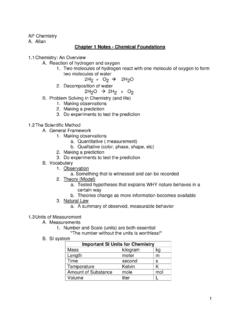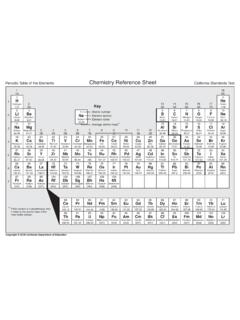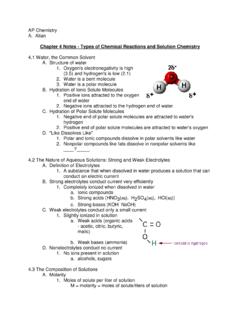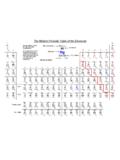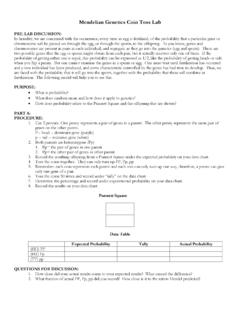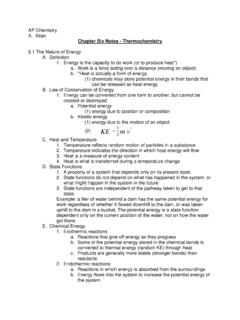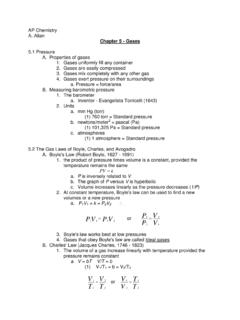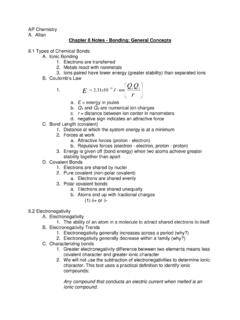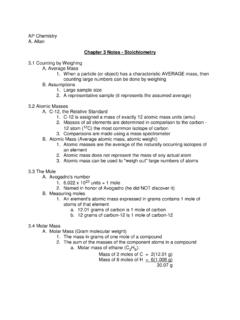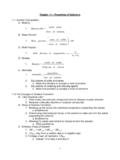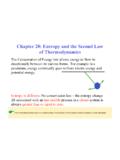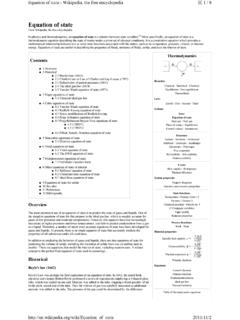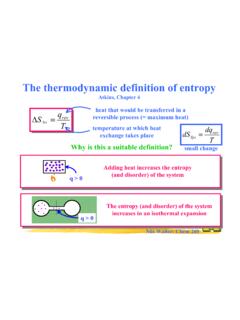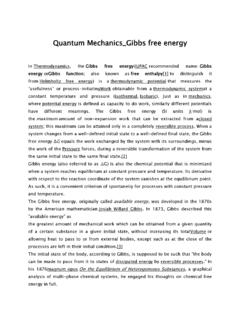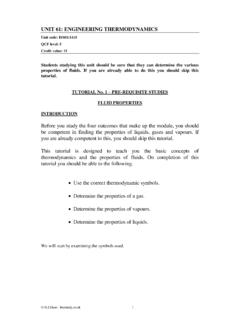Transcription of Chapter 16 - Spontaneity, Entropy, and Free Energy
1 1 Chapter 17 - spontaneity , entropy , and free Energy Spontaneous Processes and entropy A. First Law 1. " Energy can neither be created nor destroyed" 2. The Energy of the universe is constant B. Spontaneous Processes 1. Processes that occur without outside intervention 2. Spontaneous processes may be fast or slow a. Many forms of combustion are fast b. Conversion of diamond to graphite is slow C. entropy (S) 1. A measure of the randomness or disorder 2. The driving force for a spontaneous process is an increase in the entropy of the universe 3. entropy is a thermodynamic function describing the number of arrangements that are available to a system a. Nature proceeds toward the states that have the highest probabilities of existing D.
2 Positional entropy 1. The probability of occurrence of a particular state depends on the number of ways (microstates) in which that arrangement can be achieved Ssolid < Sliquid << Sgas entropy and the Second Law of Thermodynamics A. Second Law of Thermodynamics 1. "In any spontaneous process there is always an increase in the entropy of the universe" 2. "The entropy of the universe is increasing" 3. For a given change to be spontaneous, Suniv must be positive Suniv = Ssys + Ssurr The Effect of Temperature on spontaneity A. Direction of Heat Flow 1. entropy changes in the surroundings are primarily determined by heat flow a. Exothermic reactions in a system at constant temperature increase the entropy of surroundings b.
3 Endothermic reactions in a system at constant temperature decrease the entropy of surroundings c. The impact of the transfer of a given quantity of Energy as heat to or from the surroundings will be greater at lower temperatures free Energy (G), also called "Gibbs free Energy " A. Calculating free Energy Change (constant temperature and pressure) 1. G = H - T S a. H is enthalpy b. T is Kelvin temperature 2 B. free Energy and spontaneity 1. Reactions proceed in the direction that lowers their free Energy (- G) Value of H Value of T S Value of G spontaneity Negative Positive Negative Spontaneous Positive Negative Positive Nonspontaneous Negative Negative ??? Spontaneous if the absolute value of H is greater than the absolute value of T S (low temperature) Positive Positive ?
4 ?? Spontaneous if the absolute value of T S is greater than the absolute value of H (high temperature) entropy Changes in Chemical Reactions A. Constant Temperature and Pressure 1. Reactions involving gaseous molecules a. The change in positional entropy is dominated by the relative numbers of molecules of gaseous reactants and products 2C2H6(g) + 7O2(g) 4CO2(g) + 6H2O(g) 9 molecules 10 molecules S increases B. Third Law of Thermodynamics 1. "The entropy of a perfect crystal at O K is zero" (NO disorder, since everything is in perfect position) C. Calculating entropy Change in a Reaction otsreacrproductspreactionSnSnStan00 = 1. entropy is an extensive property (a function of the number of moles) 2. Generally, the more complex the molecule, the higher the standard entropy value free Energy and Chemical Reactions A.
5 Standard free Energy Change 1. G0 is the change in free Energy that will occur if the reactants in their standard states are converted to the products in their standard states 2. G0 cannot be measured directly 3. The more negative the value for G0, the farther to the right the reaction will proceed in order to achieve equilibrium a. Equilibrium is the lowest possible free Energy position for a reaction B. Calculating free Energy Change 1. Method #1, for reactions at constant temperature: G0 = H0 - T S0 2. Method #2, an adaptation of Hess's Law: Cdiamond(s) + O2(g) CO2(g) G0 = -397 kJ Cgraphite(s) + O2(g) CO2(g) G0 = -394 kJ Cdiamond(s) Cgraphite(s) G0 = -397 kJ - (-394 kJ) = -3kJ (Complete example is on page 798) 3 3.
6 Method #3, using standard free Energy of formation ( Gf0) a. Standard free Energy of Formation is the change in free Energy that accompanies the formation of 1 mole of that substance from its constituent elements with all reactants and products in their standard states b. Gf0 of an element in its standard state is zero )tan(0)(00tsreacfrproductsfpGnGnG = The Dependence of free Energy on Pressure A. Enthalpy, H 1. enthalpy is not pressure dependent B. entropy , S 1. entropy depends on volume, so it also depends on pressure Slarge volume > Ssmall volume Slow pressure > Shigh pressure 2. G = G0 + RTln(P) a. G0 is the free Energy of the gas at a pressure of 1 atm b. G is the free Energy of the gas at a pressure of P atm c.
7 R is the universal gas constant, T is Kelvin temperature 3. G = G0 + RTln(Q) a. Q is the reaction quotient (from the law of mass action, section ) b. R is the gas constant ( J/K mol) c. G0 is the free Energy change for the reaction with all reactants and products at a pressure of 1 atm d. G is the free Energy change for the reaction for the specified pressures of reactants and products free Energy and Equilibrium A. Thermodynamic View of Equilibrium 1. Equilibrium point occurs at the lowest value of free Energy available to the reaction system 2. At equilibrium, G = 0 and Q = K G0 = -RTln(K) G0 K G0 = 0 K = 1 G0 < 0 K > 1 G0 > 0 K < 1 B. Temperature Dependence of K 1. 000)ln(STHKRTG = = 2. RSTRHRSRTHK00001)ln( + = + = so ln(K) 1/T 4 free Energy and Work A.
8 Relationship to Work 1. The maximum possible useful work obtainable from a process at constant temperature and pressure is equal to the change in free Energy (" free Energy " is Energy " free " to do work) wmax = G 2. The amount of work obtained is always less than the maximum B. Henry Bent's First Two Laws of Thermodynamics 1. First law: You can't win, you can only break even 2. Second law: You can't break even The amount of available free Energy of our system (Earth) is decreasing.
